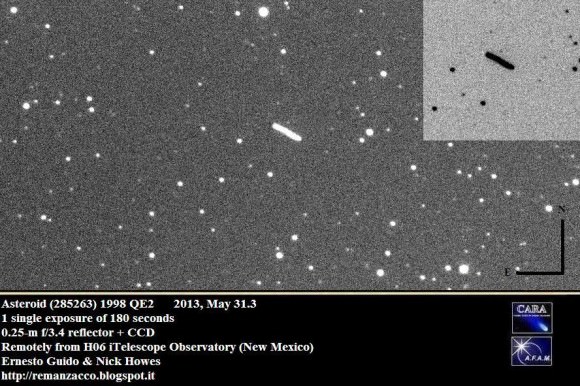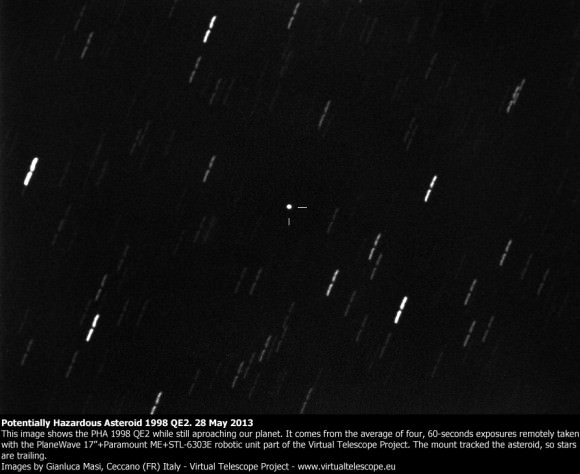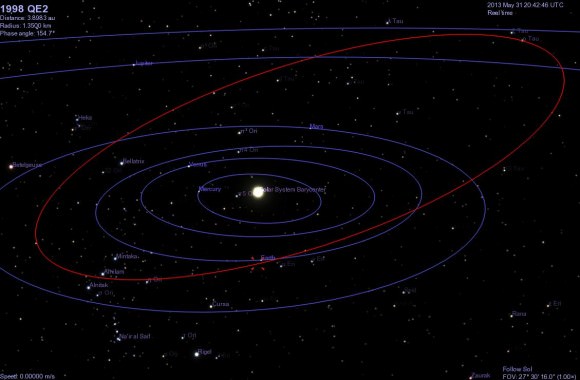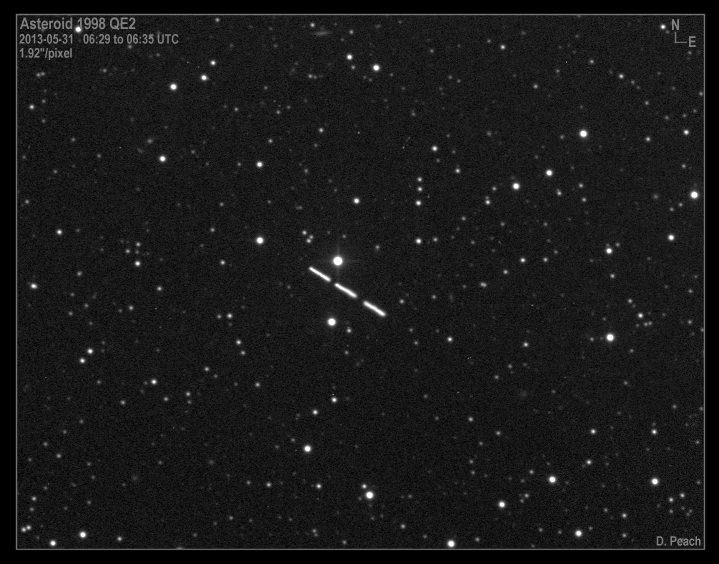Will the flyby of Near Earth Asteroid 285263 (1998 QE2) reveal more surprises? NASA announced yesterday that radar images uncovered a previously unknown small moon orbiting the big asteroid. Now, observatories and amateurs around the world are taking a look at this big, dark space rock, which is about 2.7 kilometers (1.7 miles) in diameter. Here are some of the “early returns” just in!
This asteroid will pass 5.86 million km (3.64 million miles) from the Earth on Friday, May 31st at 20:59 Universal Time (UT) or 4:59PM EDT. That is about 15 times the distance between Earth and the Moon, so no worries. But it is not often an asteroid this big comes by within viewing range of observatories on Earth.

The Remanzacco Observatory team of Ernesto Guido and Nick Howes provided this image, above, and a great animation of the asteroid, as well:
Animation of (285263) 1998 QE2 on May 31, 2013 by E. Guido & N. Howes

Masi also provided a video from his May 30 observations:

Here’s one from Ian Musgrave. If the animation isn’t working in your browser, click on the image to animate. Ian also has provided this graphic made from Celestia software to show Asteroid 1998 QE2’s orbit:

Want to try and see this asteroid for yourself? Our very own David Dickinson has written a great “how-to” for this object, but you are going to need a fairly large backyard telescope, since it will be about 100 times fainter than what can be seen with the naked eye, even at closest approach.
The Slooh online telescope will have views of online tomorrow, which you can watch at their website. The webcast will start at 20:30 UTC (4:30 p.m. EDT) on Friday, May 31.
Also, starting at 20:00 UTC (4:00 p.m. EDT), astrophysicist Gianluca Masi will have a webcast from the Virtual Telescope Project in Italy.
Also, if you want more asteroids, on Friday May 31, the White House is hosting an asteroid-themed “We the Geeks” Google+ Hangout starting at 2 p.m. EDT.
The live video conference will feature Bill Nye the Science Guy, JL Galache from the Minor Planet Center, former astronaut Ed Lu, NASA Deputy Administrator Lori Garver, and Peter Diamandis, co-founder of asteroid mining company Planetary Resources. They will discuss identification, resource potential and threat of asteroids. Here’s the link the White House’s Google+ page.
We’ll be adding more images as they come in.



In the dynamic “Animation of (285263) 1998 QE2 on May 31, 2013 by E. Guido & N. Howes,” I spot at least six wandering objects tracking through the background stars. Some of these are very faint. Any clues to their identities?
I believe they are just artfacts in the original film, not actual objects in space. Notice how they all move together and in the same direction? If you look near the center of the image, there are also faint vertical lines that are moving in the same direction exactly in step with the moving dots. I’m taking a guess here, but it’s possible the telescope filming the asteroid was not moving exactly in step with earth’s orbit, and software was used to steady the image in relation to the background stars. This made any artifacts that would otherwise be still in the original film appear to be moving in the modified version you’re seeing here. Someone please correct me if I’m wrong.
They are just hot pixels